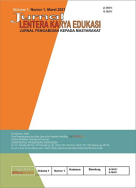KKN Tematik UPI 2023: Persepsi Masyarakat Terkait Stunting di Kelurahan Pataruman, Kecamatan Pataruman, Kota Banjar, Jawa Barat
Abstract
Full Text:
PDFReferences
Abera, L., Dejene, T., & Laelago, T. (2018). Knowledge and attitude of mothers towards child undernutrition in Mizan-Aman town, Southwest Ethiopia. American Journal of Health Research, 6(6), 127-136.
Afrida, I. (2020). Hubungan Asi Ekslusif dan Status Imunisasi dengan Kejadian Stunting di Wilayah Kerja Puskesmas Bowong Cindea Kabupaten Pangkep. Nurs Insid Community, 2(3). 106–12. Available from: http://jurnal.stikesnh.ac.id/index.php/nic/article/download/346/332/1288
Berkman, D. S., Lescano, A. G., Gilman, R. H., Lopez, S. L., & Black, M. M. (2002). Effects of stunting, diarrhoeal disease, and parasitic infection during infancy on cognition in late childhood: a follow-up study. The Lancet, 359(9306), 564-571.
Black, R. E., Victora, C. G., Walker, S. P., Bhutta, Z. A., Christian, P., de Onis, M., ... & Uauy, R. (2013). Maternal and child undernutrition and overweight in low-income and middle-income countries. The Lancet, 382(9890), 427-451.
Brown, A., & Johnson, C. (2022). Community perceptions and interventions for childhood stunting. Nutrition Reviews, 80(2), 123-135.
Headey, D., & Ecker, O. (2013) Rethinking the measurement of food security: From first principles to best practice. Food Security, 5(3), 327-343.
Hoddinott, J., Behrman, J. R., Maluccio, J. A., Melgar, P., Quisumbing, A. R., Ramirez-Zea, M., ... & Martorell, R. (2008). Adult consequences of growth failure in early childhood. The American Journal of Clinical Nutrition, 88(3), 755-761.
Hossain, M. M., & Hasan, M. T. (2020). Socioeconomic determinants of stunting among children in Bangladesh: A multilevel approach. Journal of Public Health, 28(4), 431-439.
Kementerian Kesehatan Republik Indonesia. (2018). Penelitian Tingkat Pengetahuan Masyarakat tentang Stunting di Indonesia. Kementerian Kesehatan Republik Indonesia.
Kementerian Kesehatan Republik Indonesia. (2018). Situasi Balita Pendek (Stunting) di Indonesia. Pusat Data dan Informasi Kementerian Kesehatan RI. 1–56. Available from: https://pusdatin.kemkes.go.id/pdf.php?id=18102500001
Levinson, F. J., Balarajan, Y., Marini, A. (2013). Addressing Malnutrition What Have We Learned From Recent International Experience? New York: UNICEF Nutrition Working Paper, UNICEF and MDG Achievement Fund. p. 1–64.
Mahmood, S., Sufian, M. A., & Nazri, S. (2019). Access to healthcare and child undernutrition in Bangladesh: A population-based cross-sectional study. BMJ Open, 9(8), e028187.
Rahayu, A., Rahman, F., & Marlinae, L. (2018). Buku Ajar 1000 HPK. CV Mine. http://kesmas.ulm.ac.id/id/wpcontent/uploads/2019/02/buku-ajar-1000-hari-pertama-kehidupan.pdf
Sari, K., de Pee, S., Martini, E., Herman, D., Sugiatmi, & Bloem, M. W. (2017). Estimating the risk of stunting and underweight in Indonesian children: Selection of a relevant weight-for-age reference. Public Health Nutrition, 20(1), 120-128.
Setwapres. (2018) Strategi Nasional Percepatan Pencegahan Stunting Periode 2018 – 2024 [Internet]. Jakarta: Sekretariat Wakil Presiden Republik Indonesia. 1–96.
Smith, J. (2021). The role of community perspectives in addressing childhood stunting. Journal of Public Health, 45(3), e212-e218.
Sudfeld, C. R., McCoy, D. C., Danaei, G., Fink, G., Ezzati, M., Andrews, K. G., ... & Fawzi, W. W. (2015). Linear growth and child development in low-and middle-income countries: A meta-analysis. Pediatrics, 135(5), e1266-e1275.
Sutriyawan, A., Kurniawati, R. D., Rahayu, S., & Habibi, J. (2020). Hubungan Status Imunisasi dan Riwayat Penyakit Infeksi dengan Kejadian Stunting pada Balita: Studi Retrospkektif. JMidwifery, 8(2):1–9. Available from: https://jurnal.unived.ac.id/index.php/JM/article/view/1197
Tysmala, N. D. & Widari, D. (2018). Hubungan Berat Badan Lahir Rendah dan Penyakit Infeksi dengan Kejadian Stunting pada Baduta di Desa Maron Kidul Kecamatan Maron Kabupaten Probolinggo. Amerta Nutr [Internet]. 373–381. Available from: https://ejournal.unair.ac.id/AMNT/article/view/9656/5891
UNICEF. (2020). Malnutrition and Stunting. UNICEF.
Victoria, C. G., Adair, L., Fall, C., Hallal, P. C., Martorell, R., Richter, L., ... & Sachdev, H. S. (2008). Maternal and child undernutrition: consequences for adult health and human capital. The Lancet, 371(9609), 340-357.
Walker, S. P., Chang, S. M., Powell, C. A., & Grantham-McGregor, S. M. (2007). Psychosocial consequences of malnutrition: a 20-year longitudinal study. The Journal of Child Psychology and Psychiatry, 48(8), 844-852.
Yadika, A. D. N., Berawi, K. N., & Nasution, S. H. (2019). Pengaruh Stunting terhadap Perkembangan Kognitif dan Prestasi Belajar. Med J Lampung Univ [Internet], 8(2):273–282. Available from: https://juke.kedokteran.unila.ac.id/index.php/majority/article/download/2483/2439
DOI: https://doi.org/10.17509/lekaedu.v4i1.62214
Refbacks
- There are currently no refbacks.

This work is licensed under a Creative Commons Attribution-ShareAlike 4.0 International License. View My Stats









